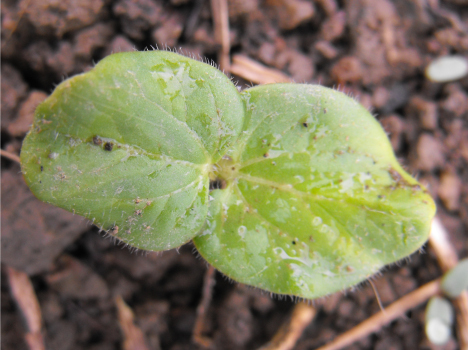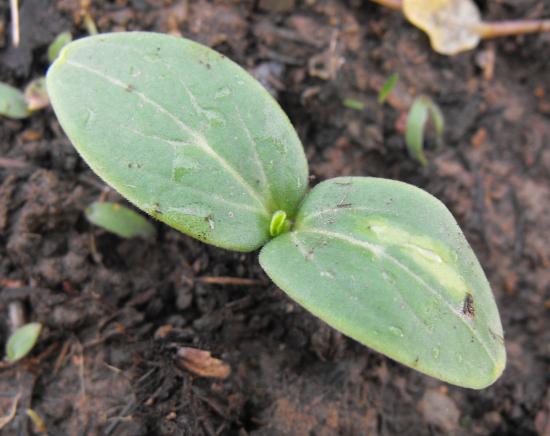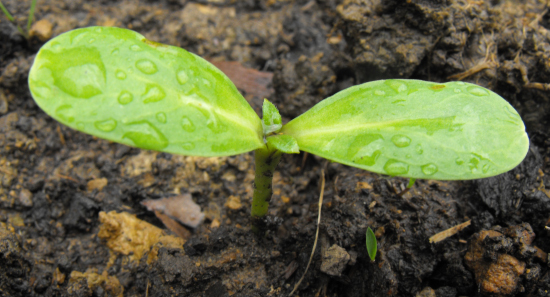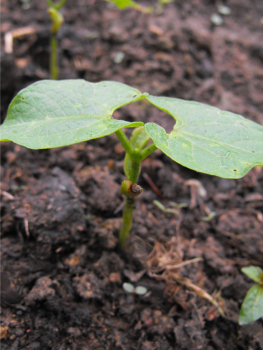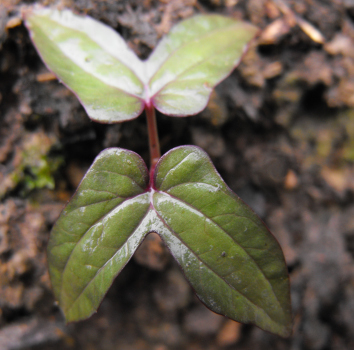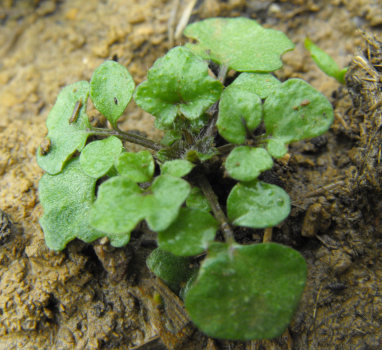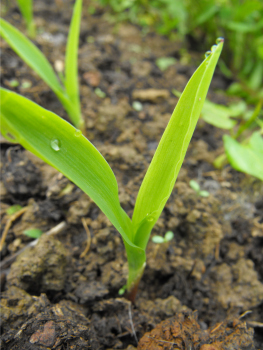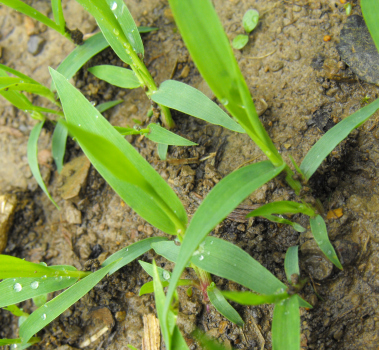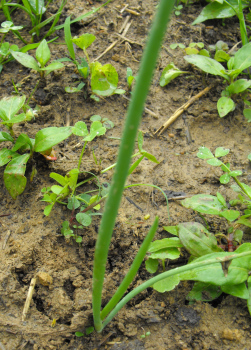
archives for 05/2009
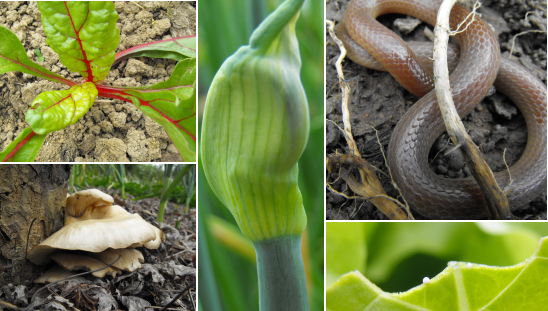
Although our calendar says that summer begins on June 21, pagans have
long celebrated May Day as the beginning of summer. I can see
their point. The woods are closing in as the leaves unfurl on
treetops, the first box turtles crawled out of their muddy hibernation
this week, and the first lightning bugs lit up our yard.
The garden is
starting to look summery too....
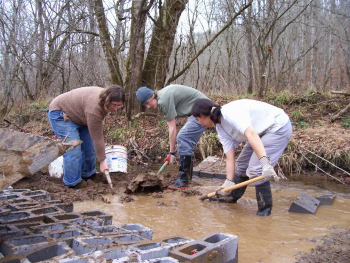 The last attribute I want to talk about is
pacing. In the last five years, I've noticed that all city
slickers (myself included) have a tendency to dive into physical labor
with two feet and wear themselves out after ten minutes or an
hour. It's easy to pick out folks used to physical labor because
they start slowly, take frequent breaks, and can keep going all day
long. In the process, those well-paced farmers get about ten
times the amount of work done as the eager beaver city-slicker did.
The last attribute I want to talk about is
pacing. In the last five years, I've noticed that all city
slickers (myself included) have a tendency to dive into physical labor
with two feet and wear themselves out after ten minutes or an
hour. It's easy to pick out folks used to physical labor because
they start slowly, take frequent breaks, and can keep going all day
long. In the process, those well-paced farmers get about ten
times the amount of work done as the eager beaver city-slicker did.
Pacing is also
important on the larger scale....
| This post is part of our Homesteading Qualities lunchtime series.
Read all of the entries: |
Jock Brandis has turned his inventive mind from being
a Key Grip on B grade movies like the sci-fi comedy Normanicus to
helping poor folks discover a more efficient method of shelling peanuts
and other material.
The design
is simple and solid and can be built for around 50 bucks. The bulk of
the invention is two concrete cones, which can be formed with a set of
fiberglass molds that Jock's North Carolina company
provides. The latest incarnation uses pedal power to get the grinding
done while producing a fan effect that helps to separate the shells
from the nut.
Someday I'd like to build one of these and try to adapt it for the
heavy walnuts that drop from the trees around here.
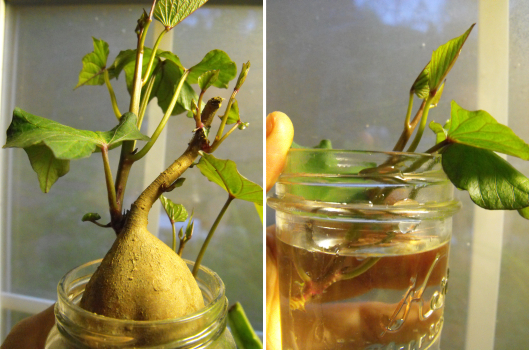
We turned off the heating mat under our sprouting sweet potatoes a week
or two ago when the daytime temperatures hit the eighties. Then I
moved them into a sunny window and the small sprouts promptly went wild.
Yesterday, I decided the biggest sprout was large enough, so I pinched
it off and moved it to its own cup of water (right photo.) Within
a week or so, this sprout will have enough roots to go in the
ground. Meanwhile, other sprouts will continue to develop on the
parent tuber. With the addition of bottom heat, starting our own
sweet potato slips turns out to be child's play!
(If you missed it, you can read about what our sweet potatos looked
like on April
9 and April 24.)
| This post is part of our How to Start Sweet Potato Slips
series.
Read all of the entries: |
One of the biggest problems with the basic
wheel barrow is the wheel.
When an inflated tire sits for a few months or longer you can expect it
to loose some of its air pressure.
The solid tire version can only handle so much weight before it gets
too hard to push.
The NuBarro from Germany seems
to be a new level in single wheeled hand trucks.
That big wheel never needs air and is extremely tough. I've never seen
this in real life, but it's easy to imagine how much more traction a
person can expect when you look at the impressive design. The maximum
weight is 750 pounds, and the price is in the 150 dollar range. A bit
more than your average wheel barrow, but it might be worth it if you're
pushing through ground heavy in sand or snow.

My brother, Joey, came over yesterday and tempted me out for a perfect
Saturday afternoon of creekwalking.
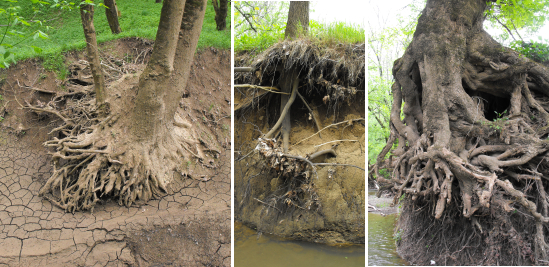
We passed trees whose
roots had been eroded bare by rushing water. (Notice the taproot
on the walnut in the center photo.) Continue the
photo adventure....
If you want something to last a million
years, then carve it into stone.
Words have a mysterious power once they make the transfer from thought
to reality, and if you want to harness the full potential of this power
you might want to consider having it written in stone.
We've had our new garden stone for about a week now and I've noticed a
slight change in the way I feel about the Waldeneffect as a concept.
The handsome rock represents another level of commitment to this life
style and provides a non physical anchor to the idea of a path that
continues to increase in sustainability as we solve each puzzle that
pops up. I was pleasantly surprised by the positive effect this little
rock ritual has had and feel like I've created a literal milestone for
our permaculture life back here in the woods.
Jeremy and Tavia at engravedstone.net can make you a customized stone
like the one pictured next to our dwarf apple tree. They have fair
prices, and a quick turn around time of only about a week.
 We
enjoyed a wonderfully rainy weekend. About an inch and a half
fell over the course of two days --- the perfect speed to soak the soil
and sprout those seeds I planted last week.
We
enjoyed a wonderfully rainy weekend. About an inch and a half
fell over the course of two days --- the perfect speed to soak the soil
and sprout those seeds I planted last week.
I also put our house plants outside to harden off in the rain.
Cloudy skies mean relatively warm nighttime temperatures, so I can be
lazy and leave the plants out all night. Usually, hardening off
is a maddening series of carrying your plants out in the day and in at
night, worrying about too much sun and too much cold. Our citrus
in their five gallon pots are not a joy to relocate over and over, so I
am thrilled to get to go the lazy route.
Meanwhile, the US
Drought Monitor tells me that the extreme southwest tip of
Virginia, where we live, has finally popped out of drought
conditions. Awesome!!!! Thanks, rain!
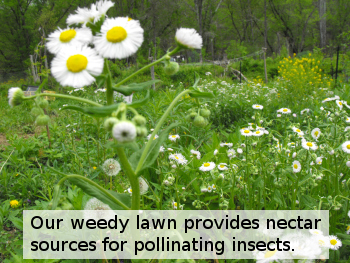 Permaculture is a method of
combining traditional agricultural systems with ecological concepts to
acknowledge the fact that no one gardens in a vaccuum. It's a pretty big idea
which will take decades to fully explore. This week, I'll just
present a smattering of concepts we're
working with at the moment, trying to create a more natural ecosystem
in our garden.
Permaculture is a method of
combining traditional agricultural systems with ecological concepts to
acknowledge the fact that no one gardens in a vaccuum. It's a pretty big idea
which will take decades to fully explore. This week, I'll just
present a smattering of concepts we're
working with at the moment, trying to create a more natural ecosystem
in our garden.
You probably already use some permaculture concepts if you garden
organically. For example, composting is a natural way of
mimicking the formation of soil. You may get some natural pest
control by leaving spots for insect-eating birds to hang out in your
garden. Those of you with honeybees have probably noticed how
they promote good pollination of your crops. On a larger scale,
we leave 90% of our property in a natural state to acknowledge the fact
that humanity has overrun the world and other living things need a
place to grow, slither, and fly, even if they have no obvious use to us.
| This post is part of our Permaculture lunchtime series.
Read all of the entries: |
While I was finishing up the ditch digging
project I noticed a significant population of grubs, which got me
to thinking about the possibility of raising meal worms for a chicken
feed supplement.
As usual the internet has quite a lot to say on the subject of meal worms, but I
found the Sialis
website and all was made clear.
It seems like a bit more work than raising worms, but once you read the
Sialis information
you'll feel like an expert.
You should be ready to wait around 3 months for your first harvest, and
most folks recommend a group of 1000 to get started, which can be had
for around 20 bucks. This could be an excellent way to raise the
quality of your eggs if your hens live in a coop and compete with a
large flock for juicy insect snacks. Stay tuned to see if I can figure
out a way to cut back on our store bought chicken feed with the help of
a well planned insect community.
| Read other posts about alternative chicken feed: |
While you're improving your chickens' healthy, you should make sure
they have clean water, an easy task with our homemade chicken
waterer.
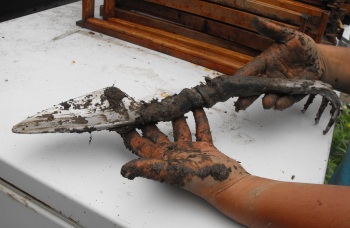 Last
week, I struggled to weed in ground gone dry and hard. In some
spots, I had to rake the surface with the back end of the trake to
loosen it enough to pull weeds loose. I probably should have just
watered the beds first, but it seemed crazy to be watering in April!
Last
week, I struggled to weed in ground gone dry and hard. In some
spots, I had to rake the surface with the back end of the trake to
loosen it enough to pull weeds loose. I probably should have just
watered the beds first, but it seemed crazy to be watering in April!
A couple of inches of rain later, it's prime weeding
weather. This is what the trake and I looked like after we
pulled a wheelbarrow and a half of weeds out of the garden. Too
bad the rain also makes the weeds grow twice as fast as I can pull them!
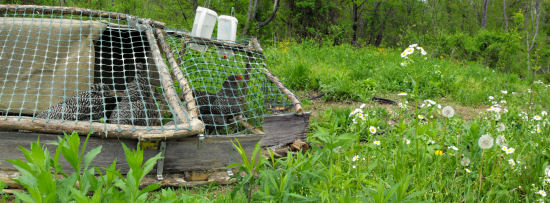
Our most obvious
permaculture technique is our chicken tractors. We have three of
them, and I wouldn't be surprised if we have twice that many in a few
years. For the uninitiated, a chicken tractor is a moveable
chicken coop/run with everything your chickens need in a small
space. Each morning, I move the tractors to a new patch of lawn,
where they scratch for bugs, engulf greenery, and fertilize the
ground. We get free lawnmowing and fertilizing along with better
eggs
while the chickens get healthy additions to their diet --- it's a
win-win.
Animals are
an important part of any natural ecosystem, but most modern
farming tries to cut them out of the picture.
| This post is part of our Permaculture lunchtime series.
Read all of the entries: |
We invented our homemade chicken
waterer specifically for tractors. Check it out to prevent
spilling of water on uneven terrain.
Today was a good day to check on our first bee
hive.
Anna is a bit troubled because we were unable to see any eggs, which
might mean the queen had some "issues" during her mating flight.
Some folks might order a replacement queen which will cost you about 40
bucks, or you can hope the colony corrects itself by making a new queen.
We've got 3 more packages of bees to pick up later this week, so we're
going to take a wait and see approach for now and hold off on ordering
a new queen.
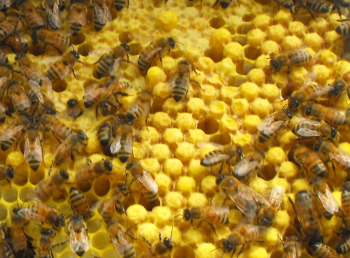 I'm an amateur beekeeper and a reforming
worrywort, which is a bad combination. As Mark posted yesterday,
our hive check showed no eggs or larvae on Tuesday. In addition,
as you can see to the left, a lot of the capped brood is drones, which
could mean our queen didn't get properly fertilized during her mating
flight. (Drones --- male bees --- come from unfertilized
eggs. You can tell drones at the pupal stage because they're
bigger, so the cells are capped with a dome raised above the surface of
the comb.)
I'm an amateur beekeeper and a reforming
worrywort, which is a bad combination. As Mark posted yesterday,
our hive check showed no eggs or larvae on Tuesday. In addition,
as you can see to the left, a lot of the capped brood is drones, which
could mean our queen didn't get properly fertilized during her mating
flight. (Drones --- male bees --- come from unfertilized
eggs. You can tell drones at the pupal stage because they're
bigger, so the cells are capped with a dome raised above the surface of
the comb.)
We also found two queen cups, which means the hive is probably not
happy with the queen and is trying to replace her. At first, I
was worried sick, but now I'm a bit intrigued. Challenges are
what make life interesting!
 Worms are one of our newer
permaculture additions to the farm. Just like chicken tractors,
worm bins add animals and fertility back to the garden ecosystem in a
controlled manner. You can read about our experiments with an
indoor worm bin here.
Worms are one of our newer
permaculture additions to the farm. Just like chicken tractors,
worm bins add animals and fertility back to the garden ecosystem in a
controlled manner. You can read about our experiments with an
indoor worm bin here.
Last week, I decided it was time to move our worms to larger quarters
outdoors. Although we'd been planning on trying an outdoor worm
bin eventually, the move was mostly the result of a mistake I
made. All winter, I kept the bin healthy by feeding the worms
solely on Mark's tea bags. But a month or so ago I started
cleaning out our winter stores, throwing in a lot of rotting sweet
potatoes and nasty frozen peaches. It was way too much food all
at once (and too wet because of the peaches), so we ended up with a
fruit fly paradise.
When we have time, we'll probably make a more professional outdoor worm
bin, but for now I put a quick one together in an afternoon. I
placed a few cinderblocks in a rectangle to form a basic perimeter,
spread my current worm bin contents over the ground in the center, and
topped it all off with a load of grass clippings from the mulching
lawnmower. It's essential that worms stay cool and damp, so I put
the outdoor bin in the shade behind the trailer where it also gets
runoff from the roof. In a few weeks, I'll give you an update on
how our exterior bin is doing!
| This post is part of our Permaculture lunchtime series.
Read all of the entries: |
Paul Stamets is an interesting guy with a
genuine desire and belief that he can help heal some of the damage
humans have done to the Earth with the help of mushrooms.
If you don't have time to read one of his 6
books, then I suggest a recent interview
by Frank Aragona as an excellent introduction to the wonderful world of
mushrooms.
This is an exceptional 2 part interview from Frank's podcast archive at
agroinnovations.com, which is
totally free of charge. You'll learn how Paul got started with
mushrooms, his work with the government and petro-chemical industry,
and a great breakdown of the history and evolution of mushrooms and how
important they are for survival.
I've heard several podcasts lately and this one really charged me up
like no other. Frank posed some great questions and Paul took the ball
and ran a few enthusiastic miles with it.
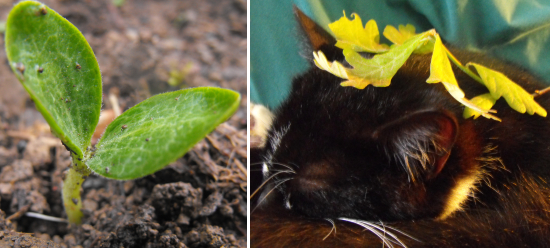
I just realized that I forgot to list all of the things we'll be
planting in May. Suffice it to say that this is the month we put
in all warm weather crops --- tomatoes, peppers, sweet potatoes, basil,
beans, corn, squashes of all sorts, cucumbers, melons. You name
it, we plant it.
Supposedly, the Native Americans planted their corn when the oak leaves
were the size of a squirrel's ear. We put in our first planting
of corn (and a lot of other vegetables) a week ago when the oak leaves
were just shy of that size. Now, after five days of solid rain,
the oak leaves are more cat-ear-sized and the first seedlings are
peeking out of the ground. The photo above is a seedling of our
favorite type of summer squash --- Goldbar.
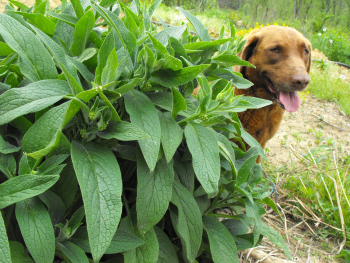 Most farmers --- and I'm no exception --- get
tunnel vision about producing the crops they're interested in.
But permaculture admonishes us to put in some species which have other
uses beyond going in our bellies. I don't spend too much time
worrying about planting nectaries since the majority of our property is
one huge nectary and our "lawn" is primarily flowering weeds. On
the other hand, I'm now starting to think seriously about dynamic
accumulators.
Most farmers --- and I'm no exception --- get
tunnel vision about producing the crops they're interested in.
But permaculture admonishes us to put in some species which have other
uses beyond going in our bellies. I don't spend too much time
worrying about planting nectaries since the majority of our property is
one huge nectary and our "lawn" is primarily flowering weeds. On
the other hand, I'm now starting to think seriously about dynamic
accumulators.
Dynamic
accumulators are plants which are good at mining nutrients out of the
soil...
| This post is part of our Permaculture lunchtime series.
Read all of the entries: |
Three more packages of bees are safely tucked away in
their new boxes. We paid 2 dollars extra and had the queens marked with
a little green dot on this batch, which seems to be worth it for the
peace of mind you get knowing for sure she's alive and kicking.
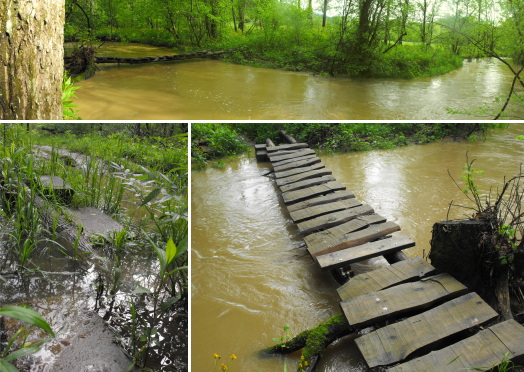
After three inches of rain in a week, the creek finally rose.
Now, I want you to imagine us carrying three boxes of buzzing bees
(screened boxes, not cardboard boxes) across this footbridge.
Then hopping across those stepping stones and scrambling up a muddy
bank. It was quite an adventure!
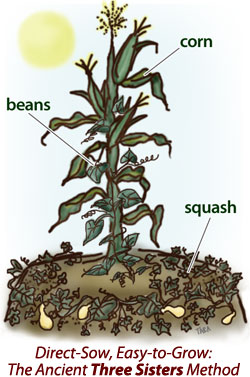 This series wouldn't be
complete without at least one good failure. Last year, I decided
to try the Native American three sisters approach to gardening,
planting hills of corn, beans, and squash together. I'll never
try that again.
This series wouldn't be
complete without at least one good failure. Last year, I decided
to try the Native American three sisters approach to gardening,
planting hills of corn, beans, and squash together. I'll never
try that again.
The theory is elegant (and a bit like a collaborative spin on
rock-paper-scissors.) The corn provides a support for the beans
to run up. The beans are nitrogen fixers which fertilize the soil
for the greedy corn plants. And the big prickly leaves of the
squash deter large herbivores and shade the soil.
In our real world trial, the plants weren't such good neighbors since
the beans and corn were stunted by the massive growth of the
squash. The prickly squash leaves did deter herbivores --- humans
wanting to pick the beans, that is. We ended up with a huge,
sprawling squash patch, nowhere near enough beans and corn, and enough
cushaws and zucchinis to feed everyone we know.
In retrospect, I made a big mistake in choosing
our seeds. Three sisters was practiced by Native Americans
growing old varieties --- we're talking field corn to make cornmeal,
not sweet corn, and runner beans, not bush beans. The problem is,
we prefer the taste of the less aggressive sweet corn and bush
beans. I'd rather use the method as the basis for a crop
rotation, keeping each type of vegetable in its own bed each
year.
But I was glad I tried it --- permaculture is all about experimentation!
| This post is part of our Permaculture lunchtime series.
Read all of the entries: |
This is just over 2 and a half minutes of our fourth bee package
install yesterday. The frames in this box have no foundation material.
Instead they have a beveled edge for the bees to begin building on. The
way I understand it the artificial foundation prompts the bees to make
bigger cells, which provide more honey. Building without this mechanism
may yield less honey, but a stronger colony. Experimenting is a big
part of the fun.
I wonder if people who keep bees tend to be more experimental?
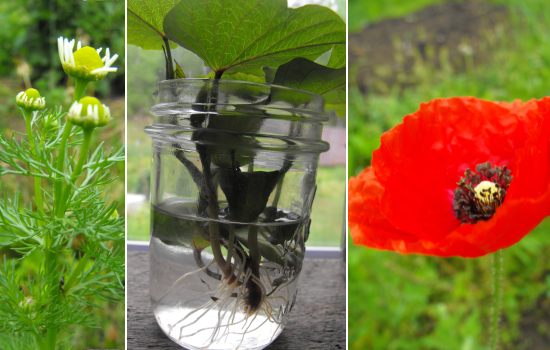
I've spent all week writing and editing so that I could turn in the
first complete draft of my book yesterday. Words may be a bit
scanty on the blog over the next few days as the well refills.
For now, enjoy a visual journey through our garden. Self-seeded
chamomile and poppies are blooming, the sweet potatoes are rooting, the
worms are slithering, and the peaches are swelling.
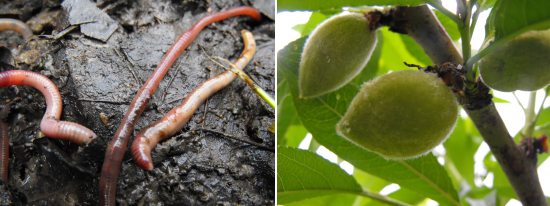
The C-realm podcast is an
evolving expression of a dynamic guy by the name of KMO. The C stands
for consciousness, and he has a way of choosing words and guests that
really take you down roads mainstream media could never even dream of.
I'm still going through his archive of shows and have really been drawn
in to the story that's unfolding. He seems to
be open to new ways of thinking when it comes to such subjects as
the re-location of community and agriculture. I think people who read
the waldeneffect might enjoy his show and I encourage everyone to give
him a listen. His new shows, which come out every week on
Wednesdays are something I now look forward to.
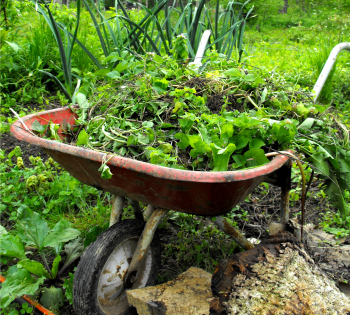 My poor sister came over Saturday morning, and
I promptly put her to work pulling weeds. The rich soil at the
south end of the garden is friable rather than muddy even after a week
of heavy rain. I'd be making mud pies if I was in the clayey
north side of the garden right now, so I steer clear.
My poor sister came over Saturday morning, and
I promptly put her to work pulling weeds. The rich soil at the
south end of the garden is friable rather than muddy even after a week
of heavy rain. I'd be making mud pies if I was in the clayey
north side of the garden right now, so I steer clear.
Despite being a bit overwhelmed by the sheer amount of weeds currently
in the garden, I have to admit that there is something deeply
satisfying about filling wheelbarrow after wheelbarrow with
weeds. I've started dumping them where I want raised beds in my
forest garden, which seems to be working pretty well. After about
a week of sun, most of the weeds die into rich soil and mulch. I
throw some cardboard or several layers of paper over that and cover it
with woodchips to hold down the more tuberous weeds. Then I plant
I-can-grow-anywhere comfrey straight into the rotting weeds, and the
dynamic accumulator takes off.
It's been a few days since the new bees have been installed, so today
was inspection day. Only 1 out of the 3 new queens had been freed by
the workers. A friend recommended a small nail hole in the remaining
candy to help the escape along. The candy barrier is there to give the
colony time to get accustomed to the new queen's scent. The workers eat their way through it because they know the queen's on the other side.
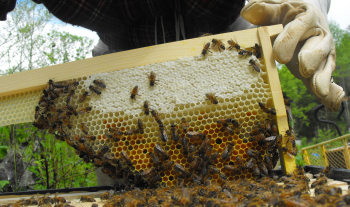 I'm starting to get a handle
on foundationless bee
frames. I've tried three methods, a good one, a mediocre one,
and a bad one.
I'm starting to get a handle
on foundationless bee
frames. I've tried three methods, a good one, a mediocre one,
and a bad one.
The mediocre one was the one I started with, which you can see to the
right. I cut each sheet of foundation into five pieces,
sandwiched one foundation piece between the wooden strip and the rest
of the frame, and nailed the wooden strip into place with vertical
nails. The bees built down from the foundation piece just fine,
but the foundation tended to slip loose before they started building on
it. I had to reattach about a third of the foundation pieces in
the first week, after which all was well.
Read more
about my experiments with foundationless honeybee frames....
| Read other posts about foundationless frames and varroa mites: |
Have you ever been out
in the garden weeding and had to go check your garden map because you
weren't sure which plants were vegetables and which were weeds?
It's time for the name that seedling quiz! (No fair using a text
only browser or looking at the image file names.)
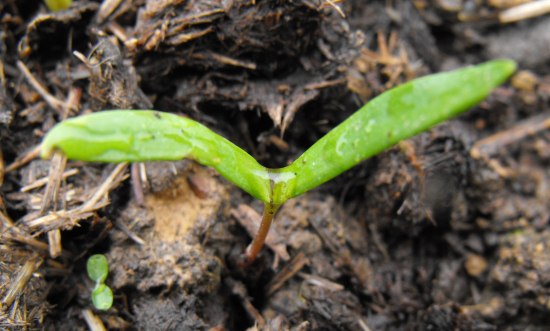
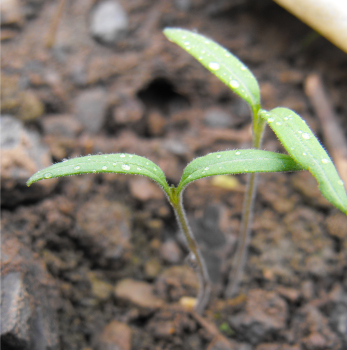
Click for answers....
| This
post is part of our Name That
Seedling Quiz lunchtime series.
Read all of the entries: |
This year's crop of garlic seems strong enough to last the entire season. It's one of the few staple items we have to buy and
it always stings at the grocery store because I know 90 percent of the
garlic in this country is grown in California, and that's a long way
from being local.
We planted several different kinds back in the fall to find out which
variety is best for our climate. With any luck our store bought garlic
days are going to be over some time next month.
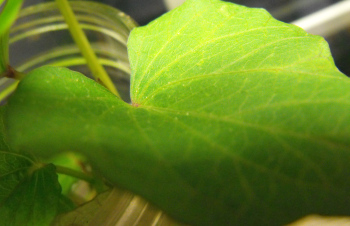 When I see a problem with one of my plants, my
first thought is, "Okay, is this caused by a bacterium, fungus, or
insect?" It took me half an hour on Monday to realize that the
white specks on the upper leaves of my sweet potato slips were none of
the above.
When I see a problem with one of my plants, my
first thought is, "Okay, is this caused by a bacterium, fungus, or
insect?" It took me half an hour on Monday to realize that the
white specks on the upper leaves of my sweet potato slips were none of
the above.
The Cornell
University Plant Disease Diagnostic Clinic resolved my mystery:
Oedema is most prevalent in the late winter especially during extended periods of cool, cloudy weather. It is likely to develop when the soil is warm and moist and the air is cool and moist. This environment results in rapid water absorption from the soil and slow water loss from the leaves.
I turned off the grow
light when I moved all of the other plants outside to harden off, which
(along with a week of rain and high humidity) slowed transpiration of
water out of my sweet potato slips. I've turned the grow light
back on to help the slips transpire until the sunny weather returns.
Now that you're all warmed
up, let's try some harder seedlings:
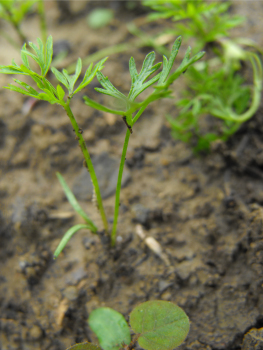
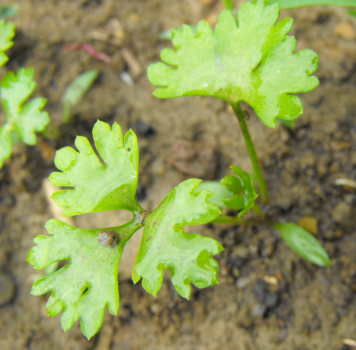

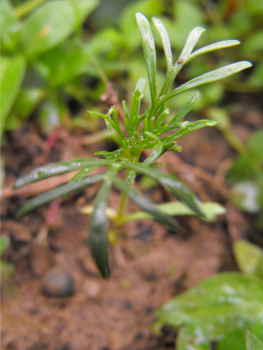
Click for answers....
| This
post is part of our Name That
Seedling Quiz lunchtime series.
Read all of the entries: |
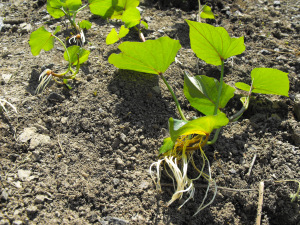 Some of the sweet potato starts graduated to
outdoor living today. They might need some supplemental water for the
first few days if they show signs of wilting.
Some of the sweet potato starts graduated to
outdoor living today. They might need some supplemental water for the
first few days if they show signs of wilting.
If you're crazy about sweet potatoes then you might want to add the Tater
Day festival to your calender for next year. It's the first Monday
in April, and the only place in the world that honors the sweet potato
with its own parade and celebration.
George
Washington Carver did some interesting work with sweet potatoes
back in the late 1930s. He figured out a way to make a corn syrup
substitute that leaves behind a sweet potato sugar. The process can be
done at home and the link has all the info.
This might be a good experiment to do in the fall.
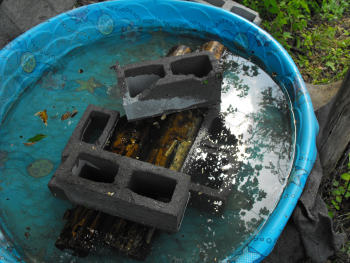 I finally got my act together Tuesday and
started soaking our shiitake mushroom logs. I suspect that I
could have done this earlier in the year, but during our blueberry
patch clearing operation, a tree fell on the logs and I hadn't gotten
around to excavating them.
I finally got my act together Tuesday and
started soaking our shiitake mushroom logs. I suspect that I
could have done this earlier in the year, but during our blueberry
patch clearing operation, a tree fell on the logs and I hadn't gotten
around to excavating them.
The logs we're soaking are two years old. We inoculated them in
spring 2007 and ignored them all that year. Then, in 2008, we
started soaking them and harvesting mushrooms. Each week during
warm weather, I soak two or three logs for 24 hours, which prompts them
to produce mushrooms.
Our soaking setup is extremely simple, but there are a few
tricks. We level the ground underneath the kiddie pool, then lay
down an old carpet to protect our $11 plastic investment. We
discovered that it's much easier to keep the logs submerged by putting
a cinderblock on each side and then two to four on top. Until you
try it, you probably can't imagine what a pain it can be to try to sink
three bobbing, rolling logs....
If everything goes as planned, we'll be eating mushrooms next week!
| This
post is part of our Name That
Seedling Quiz lunchtime series.
Read all of the entries: |
This angry looking hen is our one and only
Cochin breed.
She's been displaying all the classic signs of being broody.
The last couple of days she has insisted I leave the day's haul of eggs
with her for safe keeping.
We've been debating the possibility of buying a few fertilized eggs for
the next generation of birds, and our white Cochin could do most of the
work. It might be a skill that saves her from an early retirement.
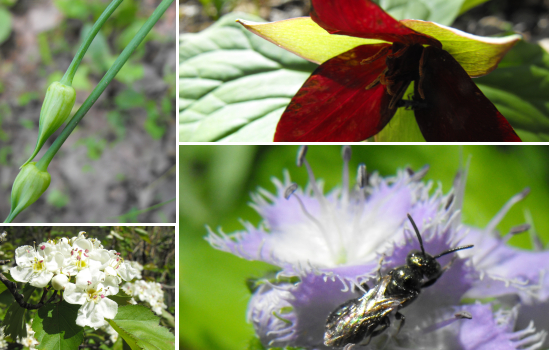
As part of our recession-proof income diversification, I've been
leading a group of ecotourists around the area this week. I've
had a blast, getting paid to wander around in the woods identifying
flowers. If I weren't such an introvert that I require an hour of
decompression for each hour I spend in the company of people, I'd do
this more often. 
| This
post is part of our Name That
Seedling Quiz lunchtime series.
Read all of the entries: |
Meow meow meow meow, meow meow's meow meow!
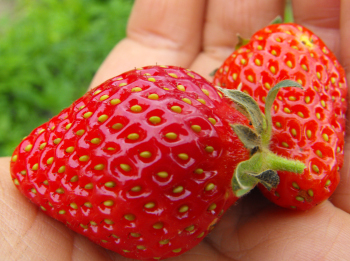 Mom emailed me to let me know that she was
eating the first strawberries out of her garden. Did I have any?
Mom emailed me to let me know that she was
eating the first strawberries out of her garden. Did I have any?
Nope, I replied, thinking with a touch of envy about her city garden
which concentrates the spring heat and fruits early.
Then I realized that I actually hadn't checked on the strawberries all
week. They're in the part of the garden which hasn't been weeded
yet, and I've been avoiding it because the weeds give me fits. I
wandered over, and, sure enough --- strawberries!
I have to admit that I ate two before I was able to bring one in to
Mark. Shh! Don't tell him!
| This
post is part of our Name That
Seedling Quiz lunchtime series.
Read all of the entries: |
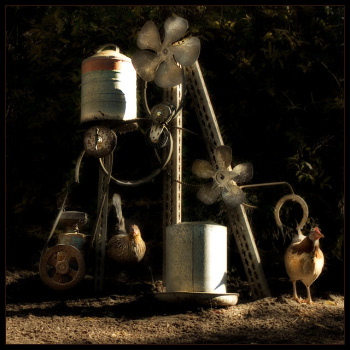 I'm not exactly sure what Steve M
was thinking when he designed this beast of a machine, but I like the
direction he's going.
I'm not exactly sure what Steve M
was thinking when he designed this beast of a machine, but I like the
direction he's going.
Sometimes a machine doesn't need a good reason to exist other than the
fact that it hasn't been done before.
The combination of wind power and chickens attracted my attention like
a magnet.
While we're on the topic of automatic chicken care, check out our homemade chicken
waterer which gives your birds clean water for days.
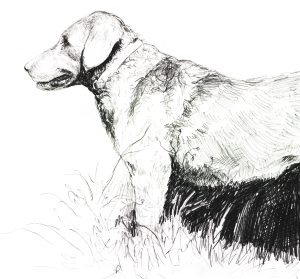 A good dog is very important on the farm, and
Lucy is definitely a good dog. But she does have a few bad
traits. A couple of nights a month, she goes on a barking jag and
it's extremely difficult to stop her. I pull the covers over my
head, turn on the fan, and remind myself that folks in the city have to
deal with noise every night.
A good dog is very important on the farm, and
Lucy is definitely a good dog. But she does have a few bad
traits. A couple of nights a month, she goes on a barking jag and
it's extremely difficult to stop her. I pull the covers over my
head, turn on the fan, and remind myself that folks in the city have to
deal with noise every night.
I think I discovered the solution, though, yesterday while listening to
Science Friday.
A dog expert explained that when a dog is barking like this ---
"Woof woof! pause Woof woof! pause" --- she's saying, "Pack
leader! Come over here and check this out!"
My response --- "Lucy! Shut up!" --- sounds to her just like
"Woof woof! pause Woof woof!" Which makes her think that I've
joined with her in calling for a pack leader, and that she should
definitely keep barking.
Instead, the dog expert suggested that I call her over and thank her
for barking and ask her to settle down. That is supposed to make
her realize that the pack leader has come out and checked on the
problem and deemed it no threat. I'm looking forward to giving it
a shot!

A stellar storyline combined with an amazing level of chemistry between
the crew equals one of the most enjoyable movie experiences I can
remember.
Watching this adventure on the big screen really allowed me to fully
lose myself in this new and exciting frontier which boldly goes where
no film has gone before.
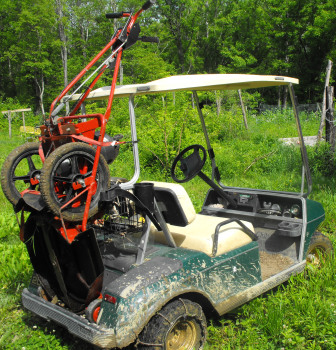 Mark picked up a commercial mower dirt cheap
last week, and Saturday was its test run. It's very powerful, but
I'm not sure where it's going to fit in our permaculture mowing system
yet.
Mark picked up a commercial mower dirt cheap
last week, and Saturday was its test run. It's very powerful, but
I'm not sure where it's going to fit in our permaculture mowing system
yet.
My hope was that the new mower would be able to cut tall grass and
leave it in one piece, to be dried into hay/straw for chicken
bedding. (I've found that mulched grass is suboptimal for that
purpose.) Unfortunately, the commercial mower works like a beefed
up version of a typical lawn mower, so it chunks up the cut grass.
Instead, I think it's probably going to be our backup mower for when
the grass grows so fast it's hard to mow with the mulching mower.
Since our last mowing a week or two ago, for example, the grass had
already licked halfway up my calf. We were glad to have the big
mower's power even if we didn't get to keep the mulch!
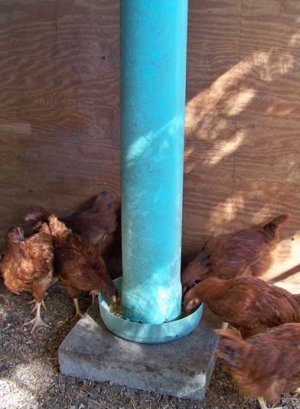
The folks at fowlvisions.com
have figured out an effective and low budget way of building an
automatic chicken feeder.
You can see more details at their fine website.
I wonder how much extra a chicken will eat under these conditions
compared to the old fashioned method we use of pouring out a set amount
of feed on the ground every morning?
Maybe a more accurate question should be at what point does more feed
stop equaling more eggs?
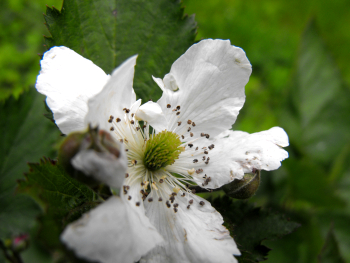 8 pm Sunday night, I checked the weather
forecast and saw a frost warning. Mark and I rushed out and
covered up half the strawberries, the summer squash, half the okra, the
watermelons, and the first bed of sweet potatoes with row covers.
I tied plastic produce bags around several of the peaches (which are
now nearly two inches long!) The temperature was 50 F, with near
total cloud cover (a good sign since clouds hold in the heat at night.)
8 pm Sunday night, I checked the weather
forecast and saw a frost warning. Mark and I rushed out and
covered up half the strawberries, the summer squash, half the okra, the
watermelons, and the first bed of sweet potatoes with row covers.
I tied plastic produce bags around several of the peaches (which are
now nearly two inches long!) The temperature was 50 F, with near
total cloud cover (a good sign since clouds hold in the heat at night.)
8 am Monday morning, the frost was beginning to melt off the
ground. Only time will tell whether we need to replant the tender
seedlings which didn't get covered --- beans, okra, canteloupe, winter
squash.
Blackberry winter! I could pretend that knowledge of this event
is why I haven't gotten my tomatoes in the ground yet, but it'd be a
bitter lie.
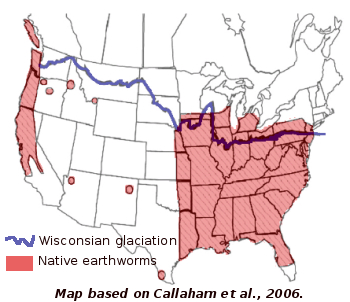 In gardening circles, worms are considered
a panacea. In ecological circles, though, you'll hear talk of the
dangers of invasive earthworms. So, what's the dirt on wrigglers?
In gardening circles, worms are considered
a panacea. In ecological circles, though, you'll hear talk of the
dangers of invasive earthworms. So, what's the dirt on wrigglers?
I've heard it bandied about that there are no native earthworms in the
U.S. Wrong. The Wisconsian glaciation, which ended 12,000
years ago, did wipe out
earthworms under the ice, but this only affected the northernmost
states. Since then, the native worms have advanced back north a
bit past the glaciation line.
Here in southwest Virginia, we've got native worms. Unless you
live out west or way up north, you probably do too.
| This post is part of our Earthworms in the Garden lunchtime series.
Read all of the entries: |
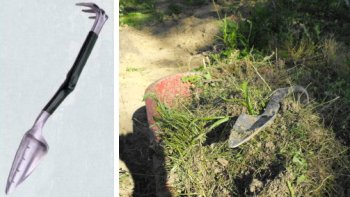 Mark: "The more I use this Trake
the more I like it."
Mark: "The more I use this Trake
the more I like it."
Anna: "Yeah....I know what you mean, the solid-cast aluminum design and
molded grip make it a tool you really miss when it's not there." -long
and dramatic sigh followed by a furrowed brow.
Mark: "Uhhhhh...maybe we should get a second Trake?"
Anna: "I think that's a great idea!"
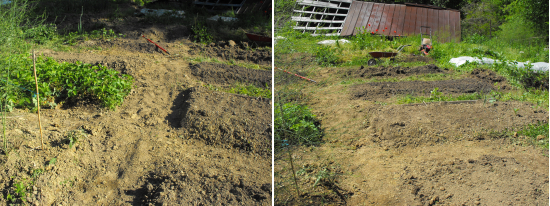
Mark and I are devoting this week to remedying a couple of major garden
mistakes we've made over the last year. The first mistake was
totally mine --- I let the weeds take over the garden in late fall last
year. In a traditional garden, this isn't a huge deal, but for
no-till it's a catastrophe since it means a major weed infestation the
next spring (right now.) Short of losing two year's soil
ecosystem growth by tilling, or buying masses of mulch to cover the
beds, the only solution is many days of hand weeding.
The second
mistake was a joint mistake....
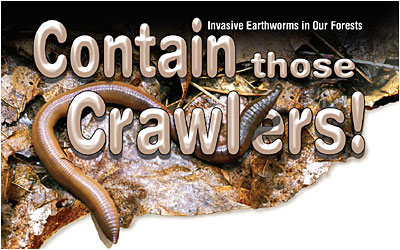 Just
because we have native earthworms, though, doesn't mean that the
invasives aren't a problem. We've introduced species from
elsewhere for bait, vermicomposting (gulp!), and accidentally in plant
roots.
Just
because we have native earthworms, though, doesn't mean that the
invasives aren't a problem. We've introduced species from
elsewhere for bait, vermicomposting (gulp!), and accidentally in plant
roots.
The biggest problems from these invasive earthworms is occurring in
previously glaciated areas where native earthworms don't occur.
There, invasive earthworms are totally changing soil dynamics by eating
up the duff (leaf litter) on the forest floor, which in turn affects
the trees and wildflowers which grow there.
Even down here in the South, we have invasive earthworms. When
competing with native earthworms, invasives tend to gain a foothold in
disturbed and fragmented forests. Scientists are beginning to
realize that invasive earthworms down here may be linked to the spread
of invasive plants like the extremely troublesome Japanese Stiltgrass
and might also compete with our forest salamanders.
| This post is part of our Earthworms in the Garden lunchtime series.
Read all of the entries: |
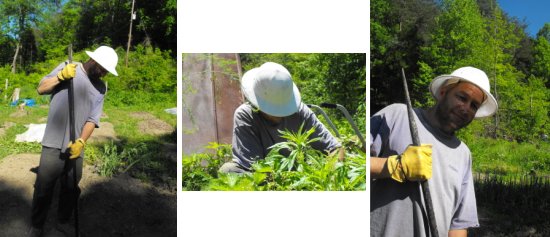
Dig, tamp, pull, and push. Repeat until garden is happy again.

Remember how I was worried two weeks ago about a bad queen bee?
I think we've experienced a successful supersedure since then!
What's a supersedure, you say? If a hive isn't happy with its
queen, they'll try to make a new one. A young larva can be moved
from the worker track to the queen track by feeding her different food
and building her a bigger cup. When the new queen reaches adulthood, the workers kill the old queen by surrounding her and causing her to overheat, then the new queen takes over the hive.
Two weeks ago, we saw two queen cups in the problem hive.
Yesterday, there were no queen cups but I saw plenty of eggs and young
larvae. It sounds like a successful supersedure, though I won't
know for sure until I see some capped larvae.
In other news, as you can see in these pictures, we've whacked the
upper garden back into shape! I'm constantly amazed at how much
Mark and I can get done when we work together.

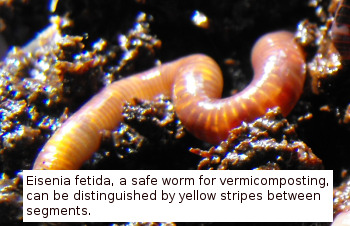 If you live north of the glaciation line, you
might want to check out this pdf
key to invasive earthworms. You can read about the ecological
groups of earthworms here,
and can also see photos of some of the worst invasives. We should
all be very careful about any earth-moving operations which can
introduce invasive worms, and should definitely refrain from dumping
excess bait worms in the wild.
If you live north of the glaciation line, you
might want to check out this pdf
key to invasive earthworms. You can read about the ecological
groups of earthworms here,
and can also see photos of some of the worst invasives. We should
all be very careful about any earth-moving operations which can
introduce invasive worms, and should definitely refrain from dumping
excess bait worms in the wild.
The question I really wanted answered, though, was --- should I hunt
down my vermicomposting worms and smash them? Lumbricus rubellus is an
invasive species which is occasionally used in worm bins.
Luckily, most vermiculture worms are Eisenia
fetida, a species that appears to be safe to use, even though
it's not from around here. You can identify the troublesome L. rubellus
by its dark red to maroon color with a yellow underside and no striping
between segments. If you have it, kill it! Luckily, it
looks like our worms are Eisenia.
| This post is part of our Earthworms in the Garden lunchtime series.
Read all of the entries: |
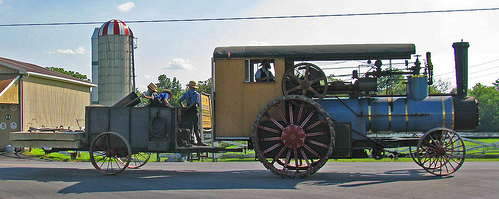
Flickr user Kevin
Borland captured the amazing image above that still has the gears
in my head turning. This Amish family seems to have evolved to a sort
of steam powered solution to farm machinery, which seems brilliant on
multiple levels.
The homesteading community could learn a lot from observing how the
Amish solve problems in such simple and innovative ways. These casual snap shots provide us one of the few looks into this interesting culture due to their clever rejection of big chunks of
the world.
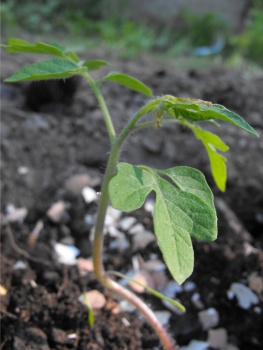 I like to plant tomatoes when my mind is empty
and my heart is full. When the sun is starting to drop down
toward the horizon, and the evening chill is creeping up through the
daytime heat.
I like to plant tomatoes when my mind is empty
and my heart is full. When the sun is starting to drop down
toward the horizon, and the evening chill is creeping up through the
daytime heat.
The spade slides down into crumbly raised bed soil, tipping a divot of
dirt to the side. I sink my fingers into manure and one big scoop
hits the hole, followed by a handful of crumbled eggshells to prevent
blossom end rot.
I slide plain soil into an indentation in the center of the amendments,
slip a tomato seedling down deep, and drench its base with sun-warmed
water. Crumbling soil up to its cotyledons, I imagine the deep
roots my tomato will grow along what was once stem.
Last year I planted tomatoes close. Most raised bed vegetables
seem not to mind rubbing shoulders, but my tomatoes glared and
sulked. So this year I've spread them wide, 37 plants in 9
beds. Nine heirloom varieties to sink our teeth into, dry,
freeze, and feed us year-round.
Tomatoes are the only vegetable I'm willing to baby, to coddle. I
imbue them with all of the spiritual strength an athiest can
muster. I almost pray.
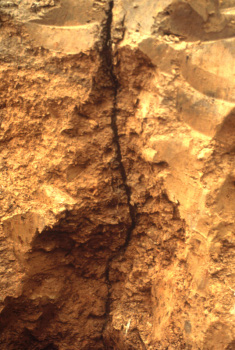 How
about in the garden? Earthworms can be very useful, speeding up
decomposition of organic matter and working it into the soil.
Their burrows also form channels which fluff up compacted soil and give
roots an easy avenue to grow down. So far, I haven't seen anybody
saying anything negative about earthworms in an agricultural setting,
though please comment if you know otherwise!
How
about in the garden? Earthworms can be very useful, speeding up
decomposition of organic matter and working it into the soil.
Their burrows also form channels which fluff up compacted soil and give
roots an easy avenue to grow down. So far, I haven't seen anybody
saying anything negative about earthworms in an agricultural setting,
though please comment if you know otherwise!
The best way to expand
your garden's earthworm population is to go
no-till. One study suggested that tilling up a garden dropped the
earthworm population to a third of its former levels. Mulching is
another way to increase your earthworm levels, as is adding lime to
raise the soil's pH. Chemicals are a definite no-no if you want
worms.
| This post is part of our Earthworms in the Garden lunchtime series.
Read all of the entries: |
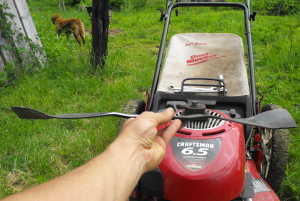 The mulch machine is out of commission for a
while due to a bent blade.
The mulch machine is out of commission for a
while due to a bent blade.
Heavy vibration and noise are a clear indicator of an out of balanced
blade.
Some people might be tempted to whack it with a sledge hammer and force
it back into shape. This will cause a weakening of the metal and might
break in two under stress, which would be very dangerous for the person
pushing it and anything else nearby.
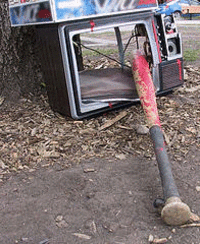 I've
been chatting over email with a reader who shares many of my same
dreams and tribulations about the journey toward simplicity. She
asked me if I could give her any advice, and the first thing I said was
to throw out the television.
I've
been chatting over email with a reader who shares many of my same
dreams and tribulations about the journey toward simplicity. She
asked me if I could give her any advice, and the first thing I said was
to throw out the television.
I know that advocating
ditching the TV sounds a bit Amish. The
Amish have been on my mind lately, partly because I'm fascinated with
them and partly because Joey recently pointed me to two
fascinating articles, one
about Amish technology and one about
Amish cell phone use.
The articles note that Amish don't reject new tchnology out of
hand. They give it a spin, let a few folks try it out to see how
it impacts their family and community life, then ditch new technology
which adversely impacts them.
Mark and I weren't really able to take that approach with television
since we'd both had the tube since childhood. Instead, we tried
the reverse --- ditching the TV when we moved to the farm and
monitoring the results....
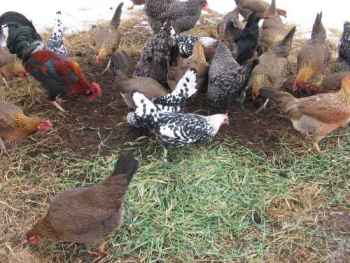 In
a permaculture situation, worms have other uses beyond soil
health. The best example comes from Harvey Ussery, who has built massive
worm bins in his greenhouse. He uses the worms to create
compost and also harvests the worms as a high protein treat for his
chickens. Maybe someday we'll have that many worms!
In
a permaculture situation, worms have other uses beyond soil
health. The best example comes from Harvey Ussery, who has built massive
worm bins in his greenhouse. He uses the worms to create
compost and also harvests the worms as a high protein treat for his
chickens. Maybe someday we'll have that many worms!
| This post is part of our Earthworms in the Garden lunchtime series.
Read all of the entries: |

The weed population in the garden is in full retreat as we continue to
get a handle on the situation.
Bjorn Astrand at Halstad University of Sweden is making some impressive
progress with his weed killing robot named Lukas.
Lukas uses on board cameras and image processing software to zero in on
its prey. You can tell from the picture that he's built for row crops,
which wouldn't cut it around here.
 As the weeds grew over
our heads (I exaggerate only slightly), Mark and I decided we needed to
look for help. We tossed around the idea of hiring a part-time
helper or getting an intern from the local college. But we
finally settled on WWOOF. For a minimal fee
($5), the
organization hooks up folks interested in learning about organic
farming with farmers. We get free labor and they get an education
and free room and board.
As the weeds grew over
our heads (I exaggerate only slightly), Mark and I decided we needed to
look for help. We tossed around the idea of hiring a part-time
helper or getting an intern from the local college. But we
finally settled on WWOOF. For a minimal fee
($5), the
organization hooks up folks interested in learning about organic
farming with farmers. We get free labor and they get an education
and free room and board.
Most WWOOF hosts ask their WWOOFers to stay for at least two weeks, but
we're not ready to make that kind of commitment. Instead, we're
looking for people who want to experience the
Walden Effect
for a weekend. If you're interested, give us a holler! We're
intrigued by the idea of meeting likeminded folks while also pulling
some weeds.
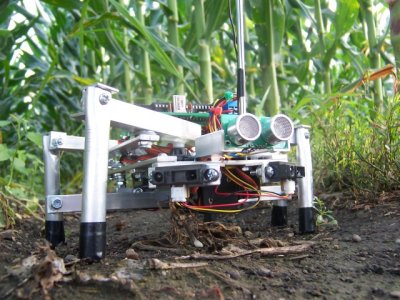 I've discovered that several people
are working on a serious robotic solution to weed control all around
the world.
I've discovered that several people
are working on a serious robotic solution to weed control all around
the world.
In my opinion the little
guy pictured to the right has the most promise for widespread
acceptance.
He seems to be small enough to make mass production possible and I
would imagine any successful product would need to function on a
minimum of power. A happy ending would be some sort of solar docking
bay the robots returned to when they got low on juice.
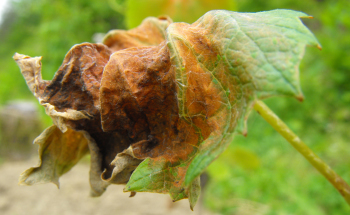 I got so caught up in weeding this week that I
forgot to let you all know what happened with our Blackberry
Winter. Basically, there were little bits of nippage here and
there, but no one died.
I got so caught up in weeding this week that I
forgot to let you all know what happened with our Blackberry
Winter. Basically, there were little bits of nippage here and
there, but no one died.
In fact, I might have been better off not
covering the peach --- the bags seemed to cause about half the fruit to
drop off. The cucurbits and okra, though, clearly enjoyed their
blanket. In retrospect, I probably should have covered the grape
cuttings we had stuck in the ground a month ago --- their leaves got
nipped back and I'm not sure if they'll be able to recover. Live
and learn!

The robot's
day in the sun is fast approaching. From the level of research being
done one can predict that an affordable garden robot might be here
within 5 to 10 years.
What would happen if we grew to rely on such robots for the bulk of our
agricultural work? Is there a danger in becoming dependent on this type
of technology?
I'm not sure I would feel the same if I let a machine do all the work
and never got my hands dirty.
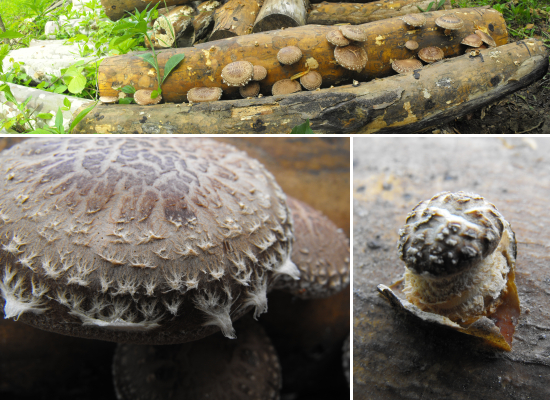
I'm usually the reincarnation of Aesop's ant, but as the first produce
comes out of the garden I turn into the grasshopper. Half a
gallon of strawberries? We'll serve them for breakfast, lunch,
and dinner! The first flush of shiitakes and the first handful of
snow peas? Eat them up!
After a few weeks, I'm sure I'll start refilling the freezer. But
for now, it's such a joy to be eating fresh food again after a winter
of frozen.
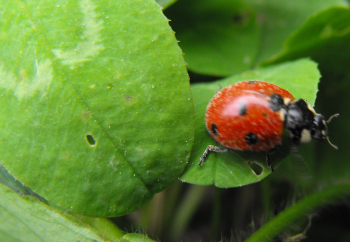 There
are just shy of a million insect species in the world, and sometimes I
think that the majority of them inhabit my garden. I'm constantly
stumbling across new forms --- brilliant, metallic beetles, soft-bodied
grubs, fantastical fliers. As with last week's earthworms, I'm
stuck with a conundrum --- should I squish them or love them?
There
are just shy of a million insect species in the world, and sometimes I
think that the majority of them inhabit my garden. I'm constantly
stumbling across new forms --- brilliant, metallic beetles, soft-bodied
grubs, fantastical fliers. As with last week's earthworms, I'm
stuck with a conundrum --- should I squish them or love them?
Last year, our single book purchase was Garden
Insects of North
America, a 656 page tome with nearly half those pages full of color
photos. As the book's wisdom slowly starts percolating into my
thought processes, I'm realizing that my best bet is to learn the bad
bugs and assume everyone else is either benign or actively
beneficial.
This week, I'm going to point out the four worst insects plaguing our
garden right this instant. Of course, the insect fauna of the
garden changes with the seasons, so there will be new insects to learn
throughout the year. If I remember, I'll post about the new bad
bugs as I cruise the garden over the weeks to come.
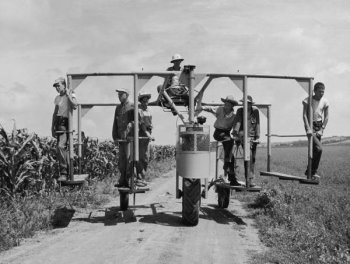 When I was a youngster the first thing I
wanted to be when I grew up was a garbage man. Why? Because I thought
it was very cool to hang off the back of the truck while it was still
moving down the road.
When I was a youngster the first thing I
wanted to be when I grew up was a garbage man. Why? Because I thought
it was very cool to hang off the back of the truck while it was still
moving down the road.
I never did get to realize that dream, but the corn hybrid crew in the picture
to the right seems like an even better gig.
They positioned young men on these machines and drove down rows of
corn. The goal was to de-tassel a row to allow the pollen from the
other row to spread by wind to form a hybrid seed corn.
 I wandered into Mark's room and saw that he
was listening to the Agroinnovations
podcast. "Tell us more about your back to the land story," I
heard.
I wandered into Mark's room and saw that he
was listening to the Agroinnovations
podcast. "Tell us more about your back to the land story," I
heard.
Then Mark's voice popped out of the computer. "Well, like a lot
of stories, it starts with a girl..."
Awww! :-) I had to listen to the whole thing, and I hope you will
too. This was the first time Mark had been interviewed for a
podcast, so he was a bit nervous. But I suspect you'll like
hearing his story as much as I did.
Episode
53: The Walden Effect with Mark Hamilton.
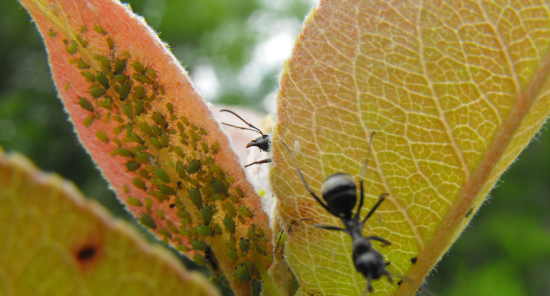
I have to admit that I have a soft spot in my heart for aphids.
Sure, they suck the life out of my vegetables, but did you know that
ants farm aphids just like we farm chickens?
| Species: Many species in the
aphid family (Aphididae) Plants Affected: many types of fruits and vegetables and ornamental plants Natural Enemies: Lady bugs, lacewings, syrphid flies, parasitic wasps. (It's far better to encourage natural populations of these predators than to introduce them.) Organic Control: Hosing with water; insecticidal soap (but may harm natural predators) |
An aphid feeds by sticking
its mouthparts into the phloem ("vein") of a
plant. The sap in the plant's phloem is under pressure, so the
liquid rushes into the aphid's body, passing so quickly through its gut
that a large amount of excess sap passes straight through the insect
and out the other end. This liquid, known as honeydew, is high in
carbohydrates. Enter the ants. Ants consume the second-hand sap, but they also take care of the aphids to make sure their meal tickets stay alive. They'll chase away predators and move aphids to new plants. In my garden, aphids don't tend to be a huge problem. In the spring, I start to see their populations exploding, then ladybug larvae show up and eat the aphids. The ecosystem tends to equalize at low levels of both aphids and ladybugs. If I'm concerned about an aphid infestation, I usually just squish them with my fingers or spray them with a hose. |
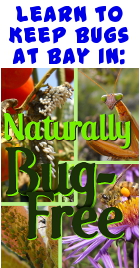 Read other posts about Organic Insect Control: Read other posts about Organic Insect Control: |
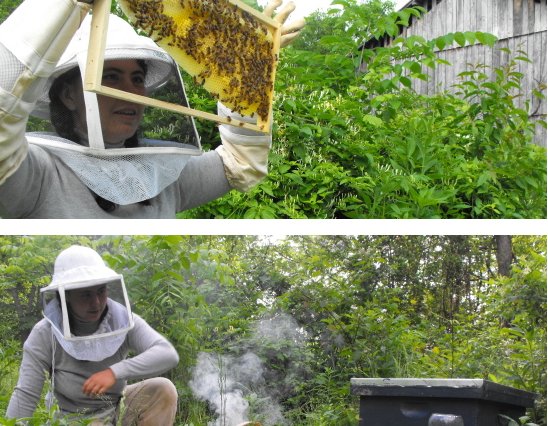
All four colonies are thriving and doing everything they should be
doing. The sugar water free ride is coming to an end as we've decided
it's time to stop feeding and let them get all their nutrition from the
local ecosystem.
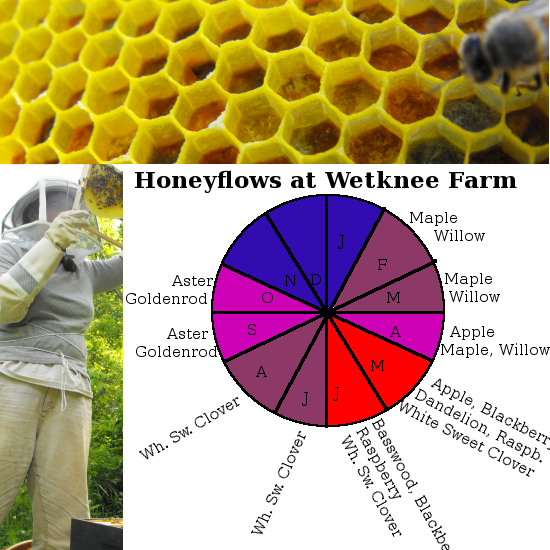
Every beekeeper I talk to seems to think that a different plant is the
be all and end all when it comes to pollen and nectar production.
I finally tracked down some hard data --- Some Ohio
Nectar and Pollen Producing Plants from the Ohio Extension Service
--- which laid all the guesswork to rest.
Based on their table of major nectar and pollen producers, I've
discovered that May and June will be the major honey production months
on our farm. It sounds like we're going to get a summer lull if
we don't come up with some more extensive White Sweet Clover patches.
Or discover some other summer-producers....
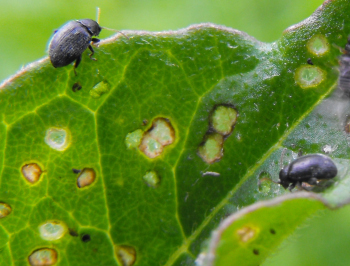 Flea
beetles are a fact of life here on the farm. If you see tiny
holes speckling your vegetable leaves and little black bugs jumping
off the plants, you're infested.
Flea
beetles are a fact of life here on the farm. If you see tiny
holes speckling your vegetable leaves and little black bugs jumping
off the plants, you're infested.
As with aphids, I tend to take a live and let live approach to flea
beetles. Unless my plants are stressed, flea beetles don't tend
to build up to very serious levels. If I'm feeling aggressive,
I'll sprinkle wood ashes on the leaves, which is supposed to cut down
on flea beetles. I'm not sure I've ever seen a real reduction
after treatment, but on the other hand I've never had a really bad
infestation of flea beetles.
| Species: Potato Flea Beetle (Epitrix cucumeris) Plants Affected: potatoes and tomatoes Related Species: Several other flea beetle species feed on nightshade family plants and cabbage family plants (along with some less common species which hit several other types of plants.) The species which feeds on eggplant is serious bad news! Natural Enemies: Lacewing larvae, Big-eyed Bugs, Two-lined Collops, Western Damsel Bug, and Northern Field Cricket, but most predators aren't present in early spring when flea beetles are a problem. Organic Control: sprinkling wood ashes; no till soil management; floating row covers over eggplants |
 Read other posts about Organic Insect Control: Read other posts about Organic Insect Control: |
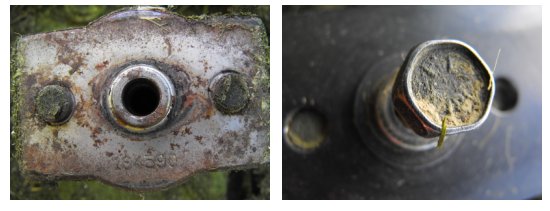
If you get a lawn mower blade installed backwards it'll still cut some
grass, just not as smooth and crisp as having it cut the right way.
You might want to confirm this as soon as you start up the new blade as
opposed to mowing all day and then asking yourself why it's not slicing
through the lawn like its usual ninja self.

Black Locust wasn't listed as a major honeybee pollen and nectar plant
on the webpage I linked to yesterday, but the species came highly
recommended during the bee workshop we attended last month. So I
poked around a bit more on the internet and stumbled across NASA's HoneyBeeNet.
The site includes a very comprehensive forage map
which divides the entire U.S. into regions and lists the primary pollen
and nectar producing plants for each region. Black Locust is
among the top seven plants listed for our region.
So, a couple of a weeks ago, I asked Mom if she had any Black Locust
seedlings under her trees that I could transplant to our farm.
"Are you sure you don't have one in your woods already?" she responded.
"Our forest is too old to have Black Locusts in it," I huffed, thinking
unkind thoughts about silly parents who don't understand forest
succession.
So she saved a seedling for me, and last Wednesday I brought it
home. Now, where to put it? I wandered around looking for a
good spot, then decided to plant it in some very young woods at the
edge of our yard. "A few of those little trees will need to come
down to give it light," I thought. I peered up into the canopy
--- and discovered half a dozen little Black Locusts growing above my
head. They weren't blooming because Japanese Honeysuckle had them
nearly smothered, but I pried them free and have high hopes they'll
bloom next year. Now I just have to apologize to Mom....
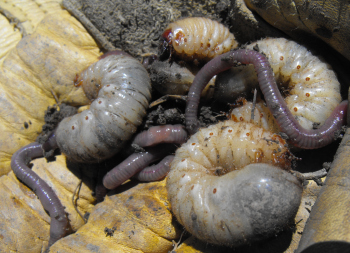 Whenever
I poke around in our soil, I usually come across some big white
grubs. Grubs are the larval form of scarab beetles, a large
family which includes over a thousand species in the U.S. and
Canada. The best known of these is the Japanese Beetle,
which can be identified by looking
at the nearly microscopic hair patterns at the butt end of the grub.
Whenever
I poke around in our soil, I usually come across some big white
grubs. Grubs are the larval form of scarab beetles, a large
family which includes over a thousand species in the U.S. and
Canada. The best known of these is the Japanese Beetle,
which can be identified by looking
at the nearly microscopic hair patterns at the butt end of the grub.
I consider grubs to be bad news, and in many cases they are since they
turn into pest beetles or eat plant roots. On the other hand,
some grubs are useful since they decompose organic matter in the
soil. Regardless, I toss them all into the chicken coop and watch
the hens fight over these fat bundles of protein, along with the worms
Mark adds to sweeten the pot.
|
Species: Many species in
Scarabaeidae (Scarab family) Plants Affected: Japanese Beetles (Popillia japonica) feed on the leaves of grapes, apples, plums, cherries, strawberries, and various ornamentals. Some grubs feed on plant roots. Related Species: Other common white grubs turn into June Beetles and several other species. Natural Enemies: Parasitic wasps, diseases including Milky Spore, nematodes. Organic Control: Traps may be worse than useless since they'll lure your neighbor's Japanese Beetles into your garden. Luckily, both the adults and grubs are very easy to handpick and the chickens love them. |
 Read other posts about Organic Insect Control: Read other posts about Organic Insect Control: |
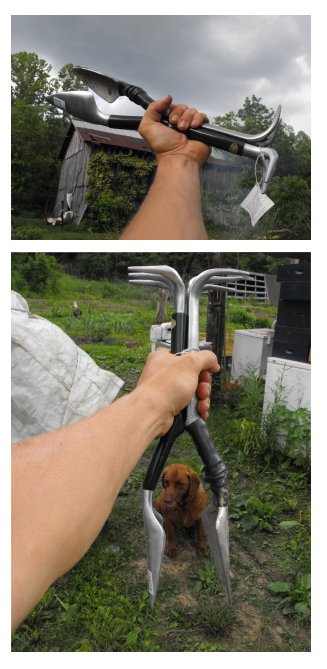
The second Trake arrived today and I can already feel an increase in
our leverage over the local weed population.
It came with a tag that proclaims it to be part of the "Hen-Feathers"
collection.
Its 16 inch length and 25 degree angle are nice, but its one piece
cast construction is what makes it such a gem in my eyes.
I'd like to see an oversize version of it as a piece of garden
sculpture in some fancy park in the city. That would be some outside
art I could get behind.
This one has a green grip, which I'm thinking of securing with
electrical tape to avoid the scrunching that happened to the original
after hours of heavy use.
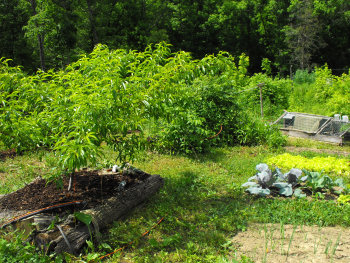 This
is the season when you can easily lose your garden if you don't keep
the weeds below the level of the emerging seedlings. So, for days
and days and days, our outdoors chores have consisted of hours and
hours and hours of weeding and mowing. I can't speak for Mark,
but I'm heartily sick of it.
This
is the season when you can easily lose your garden if you don't keep
the weeds below the level of the emerging seedlings. So, for days
and days and days, our outdoors chores have consisted of hours and
hours and hours of weeding and mowing. I can't speak for Mark,
but I'm heartily sick of it.
But Thursday afternoon I
took a little break to mulch. This
is the dessert, the gravy at the end of weeding. Well-rotted wood
chips, streaked with white lines of mycelia, sodden with imbibed
rainwater. I can't really explain why I love mulching --- maybe
because I know that for every hour I spend mulching, it saves three or
four hours of later weeding, maybe because I know the mulch will break
down and feed my perennials. Regardless, I feel revived enough to
carry on weeding like crazy for another couple of weeks until the
garden is safe.
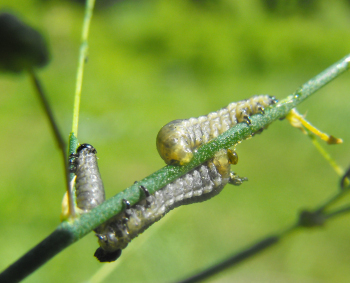 The
Asparagus Beetle is a pest I'd never heard of until I started taking
the camera out into the garden last week and hunting for bugs.
They're so small and inconspicuous that I think it's quite possible
they were here last year and I just didn't notice.
The
Asparagus Beetle is a pest I'd never heard of until I started taking
the camera out into the garden last week and hunting for bugs.
They're so small and inconspicuous that I think it's quite possible
they were here last year and I just didn't notice.
Asparagus Beetle larvae
nibble on asparagus leaves. Light
infestations are considered normal, but heavy infestations can injure
or kill the plants. I'm still in the learning stages with this
pest, so I'm going to see if any of their natural predators show
up. Meanwhile, I'm handpicking some of them to feed the chickens.
| Species: Asparagus Beetle (Crioceris asparagi) Plants Affected: Asparagus Related Species: Spotted Asparagus Beetle is similar, but the larvae only feed on asparagus berries, so they are less harmful. Natural Enemies: A parasitic wasp (Tetrastichus asparagi), a nematode (Steinernema feltiae), lady beetle larvae Organic Control: hand picking (but this is hard since the larvae are small) |
 Read other posts about Organic Insect Control: Read other posts about Organic Insect Control: |
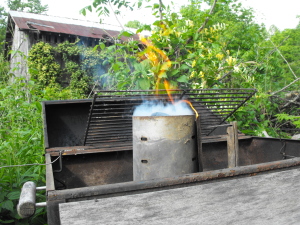 Ye olde charcoal grill saw the light of day
yesterday as we cooked up some asparagus and shitake mushrooms with a
few hot dogs on the side.
Ye olde charcoal grill saw the light of day
yesterday as we cooked up some asparagus and shitake mushrooms with a
few hot dogs on the side.
My mom introduced me to the
charcoal chimney starter years ago and grilling has never been the
same since.
Your coals get heated up faster while using less lighter fluid. If you
have a large crowd to feed you might want to have two going at the same
time.
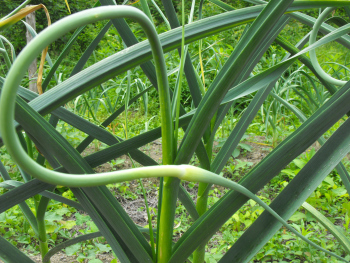 It looks like I missed out on a delicacy this
spring --- garlic scapes! We planted
four kinds of garlic last fall to test which one is the tastiest
and grows best in our soil. One kind was a hardneck garlic, which
sends up reproductive stalks (scapes) and eventually produces little
bulblets.
It looks like I missed out on a delicacy this
spring --- garlic scapes! We planted
four kinds of garlic last fall to test which one is the tastiest
and grows best in our soil. One kind was a hardneck garlic, which
sends up reproductive stalks (scapes) and eventually produces little
bulblets.
Now that the scapes are a couple of weeks old, I finally got around to
hitting the internet. It turns out that good gardeners pluck the
young scapes and eat them in stir fries, pesto, and other delicacies
when they're still young and tender. Mediocre gardeners (us,
apparently), finally remember to pluck off the scapes when they're a
little older, then discard them. Bad gardeners leave the scapes
on and end up
with garlic bulbs which are 33% smaller, on average. Next
year, we'll be good gardeners!
 Did you ever wonder which
out-of-town plants are okay to put in your flower bed and which ones
are likely to slip their leash and turn into the next kudzu infestation?
The Ladybird
Johnson Wildflower Center
has an extensive list of cultivated plants known to be invasive along
with non-invasive alternatives.
Did you ever wonder which
out-of-town plants are okay to put in your flower bed and which ones
are likely to slip their leash and turn into the next kudzu infestation?
The Ladybird
Johnson Wildflower Center
has an extensive list of cultivated plants known to be invasive along
with non-invasive alternatives.
Say you're at the local nursery and notice a pretty honysuckle for sale
--- should you buy it? Stop by the website and you'll see that
Japanese Honeysuckle is an
invasive, but that you can choose between 11 alternatives which fill a
similar niche. Just what I've been looking for!
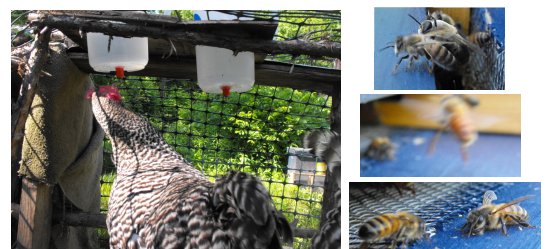
Birds drink...bees buzz....and I admire their work from afar with an ice cold glass of sweet tea. How could a Sunday be any better than this?
Want more in-depth information? Browse through our books.
Or explore more posts by date or by subject.
About us: Anna Hess and Mark Hamilton spent over a decade living self-sufficiently in the mountains of Virginia before moving north to start over from scratch in the foothills of Ohio. They've experimented with permaculture, no-till gardening, trailersteading, home-based microbusinesses and much more, writing about their adventures in both blogs and books.
